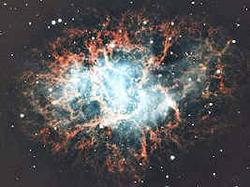Ocean Currents in a Neutron Star

After a star explodes in a supernova, it usually leaves behind an extremely dense, hot, spinning ember–a neutron star. But according to calculations in the 1 June PRL, the excitement doesn’t end with the supernova. Many neutron stars, say the researchers, slow from 1000 revolutions per second at birth to perhaps one tenth that spin rate in their first year of life, losing the energy by radiating gravitational waves. The radiation comes from the oscillatory motion of the star’s fluid in a sort of giant “ocean circulation” pattern, driven by the star’s rotation. The results suggest not only a revision in the theory of neutron stars, but also an unexpected source of gravitational radiation–the waves Einstein predicted and that physicists hope to detect unequivocally in the next decade.
Although theorists have studied many types of vibrations in neutron stars–oscillations akin to the ringing of a bell–none of these vibration patterns (or “modes”) turned out to last long when friction was accounted for, unless the star was spinning near the highest possible rate. Otherwise, these modes were found to die out quickly from friction, just as a bell’s ringing dies away with time. But last year Nils Andersson, of Washington University in St. Louis, investigated a different set of modes, ones similar to large-scale ocean currents, where the water density remains constant, and each chunk of ocean moves horizontally. In a spinning neutron star, the Coriolis force can create currents that oscillate between clockwise and counterclockwise circulation at frequencies close to the star’s rotation rate. Andersson showed that, like other modes studied in the past, if he ignored friction, these “current modes” generate waves in the star’s gravitational field in such a way that the act of radiating amplifies the motion and creates a positive feedback.
In this week’s PRL, Lee Lindblom and Benjamin Owen, of the California Institute of Technology, and Sharon Morsink, of the University of Wisconsin at Milwaukee, show that these modes can get a big enough boost from radiating gravity waves that they overpower friction, assuming the star isn’t spinning too slowly. “We were completely shocked that the gravitational radiation coupling was so strong,” Lindblom recalls, since all other neutron star oscillations had been found to couple much more weakly. They showed that a typical neutron star born at a spin rate of 1 kHz could slow to about 100 Hz in about a year–a drastic slow-down compared to accepted theories–all the while emitting copious gravity waves. Lindblom says a paper in press at Physical Review D (scheduled for publication in August) shows that these waves should be detectable by the Laser Interferometer Gravitational-Wave Observatory (LIGO) after its enhancements in the middle of the next decade.
Lars Bildsten, of the University of California at Berkeley, calls the work a “big breakthrough,” because Lindblom and his colleagues have found realistic conditions that lead to such a robust, radiating neutron star oscillation. He points out that the greatest uncertainty in the calculation is in the choice of a saturation point, where the oscillation amplitude stops growing. If the saturation occurs sooner than the authors assumed, the effect would be smaller, and the spin slowdown less dramatic. Bildsten is especially interested in the theory as a new observational tool: given the observed spin rates of neutron stars, he hopes to learn about their internal physics, such as the temperature of the expected superfluid transition that occurs as they cool.


